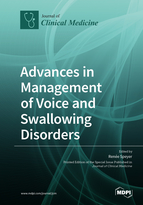Advances in Management of Voice and Swallowing Disorders
A special issue of Journal of Clinical Medicine (ISSN 2077-0383). This special issue belongs to the section "Otolaryngology".
Deadline for manuscript submissions: closed (16 November 2023) | Viewed by 43805
Special Issue Editor
Interests: dysphagia; dysphonia; laryngology; effects of speech and language therapy; instrument development; psychometrics; systematic reviews
Special Issue Information
Dear Colleagues,
You are invited to contribute to the Special Issue “Advances in Management of Voice and Swallowing Disorders,” dedicated to innovations in screening and assessment and the effectiveness of interventions in both dysphonia and dysphagia. In contemporary practice, novel techniques have been introduced in diagnostics and rehabilitative interventions (e.g., machine learning, electrical stimulation). Similarly, advancements in methodological approaches to validate measures have been introduced (e.g., item response theory using Rasch analysis), prompting the need to develop new, robust measures for use in clinics and intervention studies. Against this backdrop, this Special Issue focuses on studies aiming to improve early diagnostics of laryngological disorders and its management. This issue also welcomes the submission of studies on diagnostic accuracy and psychometrics performance of existing and newly developed measures. This includes but is not limited to studies investigating screening tools with sound diagnostic accuracy and robust psychometric properties. Furthermore, interventions with high levels of evidence in relation to clinical outcome using robust methodology (e.g., sophisticated meta-analytic approaches) are of great interest. This issue will provide an overview of the latest advances in voice and swallowing disorders.
Prof. Dr. Renée Speyer
Guest Editor
Manuscript Submission Information
Manuscripts should be submitted online at www.mdpi.com by registering and logging in to this website. Once you are registered, click here to go to the submission form. Manuscripts can be submitted until the deadline. All submissions that pass pre-check are peer-reviewed. Accepted papers will be published continuously in the journal (as soon as accepted) and will be listed together on the special issue website. Research articles, review articles as well as short communications are invited. For planned papers, a title and short abstract (about 100 words) can be sent to the Editorial Office for announcement on this website.
Submitted manuscripts should not have been published previously, nor be under consideration for publication elsewhere (except conference proceedings papers). All manuscripts are thoroughly refereed through a single-blind peer-review process. A guide for authors and other relevant information for submission of manuscripts is available on the Instructions for Authors page. Journal of Clinical Medicine is an international peer-reviewed open access semimonthly journal published by MDPI.
Please visit the Instructions for Authors page before submitting a manuscript. The Article Processing Charge (APC) for publication in this open access journal is 2600 CHF (Swiss Francs). Submitted papers should be well formatted and use good English. Authors may use MDPI's English editing service prior to publication or during author revisions.
Keywords
- Dysphagia
- Dysphonia
- Diagnostics and screening
- Assessment
- Treatment effectiveness
- Health economics
- Psychometrics







